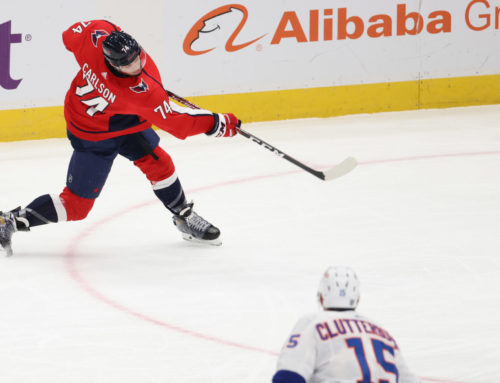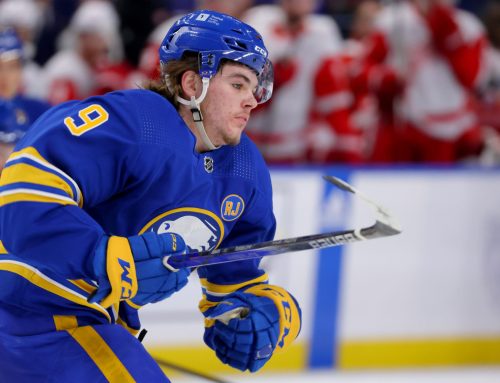In just a few days, the 2024-25 Dobber Hockey Fantasy Guide is set to be released! It has depth charts, projections, prospect coverage, rebounds, declines, breakouts, and a whole lot more. It is a digital-only copy, and that means it will be updated right up until the start of the regular season to reflect any signings, trades, injuries, or line combination movement that occurs. Help support what we do year-round and pre-order your copy now!
*
The Buffalo Sabres signed goalie Ukko-Pekka Luukkonen to a five-year contract carrying an average annual value of $4.75M. Luukkonen is coming of a breakout season with a .910 save percentage and 27 wins across 51 starts.
This is an interesting contract for the Sabres because the clock has already started on Devon Levi, and he'll be due a contract extension next summer. However, they signed James Reimer, so it seems the plan is to give Levi one more season of development in the AHL. That will make his extension next summer very cheap, so they'll probably be able to run a Luukkonen/Levi tandem for around $6M a season starting in 2025-26. With the cap over $90M at that point, it seems perfectly fine, and there are worse situations than having two 20-something goalies prove themselves as starters while on reasonable contracts.
There should be some trepidation around Luukkonen in fantasy, though. It was great to see him break out, but it basically amounted to four very good months and the team has had significant turnover, including a new coach. He looks to be the guy for now, but he's still nowhere near the top tier of goalies. He is in that mushy middle, and that can make him very valuable or an anchor in cap leagues. Goalies, man.
*
Philadelphia signed forward Travis Konecny to an eight-year deal worth $8.75M per season. He was set to be an unrestricted free agent after the 2024-25 campaign.
For fantasy, this one is dicey. I have been the conductor of the Travis Konecny Freight Train for a few years now, and it's paid off pretty well. On the flipside, in cap leagues, this is still a Flyers team that has to prove it doesn't have a basement-level power play before we can believe that Konecny is a slam-dunk point-per-game player. He can get there with a league-average power play, and adding Matvei Michkov will help, but it's a big risk in cap formats.
*
My last two Ramblings have covered the changes in peripheral fantasy hockey stats over the last few seasons with Tuesday's going over shots, hits, blocks, and PIMs (split among forwards and defencemen). On Thursday, changes in goals, assists (both first and second), special team production, and milestones reached in those categories were reviewed. Today, we'll stay with goals and assists but look at the changes among forwards and defencemen to see how the positions are evolving. We will be using Natural Stat Trick, Hockey Reference, and Frozen Tools as data sources, and we'll be covering the last three seasons only.
Let's start up front. Remember that 2023-24 saw a three-year low in goals per team per game, so there should be some kind of drop off last year, but the question is how much and how that affected the distribution of goal scoring. Here is how forwards fared in each of the last three seasons by goals and assists at various strengths:
| 2021-22 | 2022-23 | 2023-24 | YoY %Change | |
| AS Goals | 6981 | 7038 | 6927 | -1.6% |
| AS Assists | 9421 | 9598 | 9285 | -3.3% |
| PP Goals | 1401 | 1544 | 1498 | -3% |
| PP Assists | 2116 | 2327 | 2260 | -2.9% |
| SH Goals | 190 | 213 | 208 | -2.3% |
| SH Assists | 152 | 174 | 155 | -10.9% |
As mentioned in Thursday's Ramblings, the drop in short-handed assists in 2023-24 was much, much larger than the drop in short-handed goals. The guess is that it's due to aggressive PK strategies that allow for more breakaways, but it could also just be a one-year blip.
The more important note is that total assists among forwards fell at a much larger rate than goal scoring. What is curious about that is that it was the rate of secondary assists that fell significantly as the reduction from 2022-23 to 2023-24 was 5.9%. Comparatively, the drop in first assists among forwards was 1.7%, or nearly in line with the drop in goal scoring. Are official NHL scorers becoming stingier with handing out assists, or is it defencmen getting more involved? A bit more on that later.
Assists becoming more infrequent is having an impact on what the top players produce. In 2022-23, there were 60 forwards that reached at least 40 assists, while forwards that skated at least 1000 minutes averaged 31.2 assists that season. In 2023-24, there were just 51 forwards that reached at least 40 assists while the forwards with at least 1000 total minutes averaged 30.1 assists. In a 12-team fantasy leagues two seasons ago, we could reasonably expect each team to have 4-5 forwards with at least 40 assists, and now it's closer to four each. That matters when looking to fill out specific stats during a draft.
As we found in the Ramblings yesterday, the drop in goal scoring is affecting the lower-end more than it's effecting fantasy-relevant options. For example, in 2023-24 there were 135 forwards with 20-goal seasons while the 2022-23 campaign saw just 127 reach that mark. Comparatively, there were 337 forwards to score 10-or-fewer goals in 2023-24 compared to 350 the season before. It is nice that players we might draft for 20 goals are as abundant as ever, but it might indicate that finding good goal scorers off the waiver wire in-season is a bit tougher than it was 18 months ago.
The last note is while forwards scored 111 fewer goals last season compared to the one prior, 51 of those goals were either on the power play or penalty kill. In other words, nearly 46% of the entire goal-scoring drop among forwards was due to changes in special team scoring. Fantasy production relies heavily on power play production, and if that is becoming rarer to find, then it becomes more valuable to find players who can produce with the man advantage.
Alright, let's move along to defencemen. Remember that in Tuesday's Ramblings, we found that there was a drop in shot totals among forwards and defencemen, but the drop was much larger in the latter than the former. Let's gander at how production has changed at the position over the last few years:
| 2021-22 | 2022-23 | 2023-24 | YoY %Change | |
| AS Goals | 1169 | 1209 | 1157 | -4.3% |
| AS Assists | 4363 | 4293 | 4330 | +0.9% |
| PP Goals | 166 | 172 | 167 | -2.9% |
| PP Assists | 914 | 939 | 910 | -3.1% |
| SH Goals | 21 | 33 | 26 | -21.2% |
| SH Assists | 90 | 99 | 86 | -13.1% |
What sticks out immediately here is that unlike forwards, there wasn't an across-the-board production decline among blue liners when comparing 2023-24 to 2022-23. It was close, but there were more assists from blue liners in 2023-24 than the year prior despite a drop in goal scoring among defencemen, and a decline in goal scoring across the league. What is even weirder is that despite the large drop in secondary assists mentioned earlier in the section on forwards, there wasn't any such drop among defencemen. In fact, from 2022-23 to 2023-24, the number of second assists among blue liners grew by 4.8%. While it jives with how we've seen the position evolve over the last decade, it's still a bit jarring to see nearly a 5% jump in secondary assists despite a drop in league-wide goal scoring. It does help explain why forwards are registering fewer second assists.
That rise in secondary assists ties into overall production, too. While total points accumulated by defencemen did fall from 2022-23 to 2023-24, the drop was very small with just 15 fewer points at all strengths by blue liners. That represents a decline of 0.3% and that margin doesn't really matter.
There were declines in special-team production, though. The table above shows how both power play goals and assists fell around 3% when compared to 2022-23, and even larger drops in short-handed production. As for penalty kills, is it a matter of being more aggressive in the defensive zone, but if there's an offensive opportunity, the blue liners are more likely to change and get a fresh pairing on the ice than rush up to jump into the play? That kind of goal prevention would make sense, and it's notable for those fantasy owners who take part in leagues with categories for short-handed points.
There was also a lower decline in power play goal scoring by defencemen (-2.9%) than there was at all strengths. Now, when we're talking about 172-goal and 167-goal samples, there is absolutely a luck factor to consider, but that shouldn't be a huge concern for fantasy managers. It is also notable that the decline in assists from the year prior was just 3.1%, so the drops are reflective of the overall league environment and that should mean nothing much for fantasy owners to worry about other than concerns we may have about goal scoring across the league in general.
One last thing. Remember when we talked about how the number of 20-goal forwards actually increased despite the league-wide goal-scoring decline? The same was true for rearguards. In 2022-23, there were 33 blue liners who scored at least 10 goals but the number of defencemen to reach that mark in 2023-24 was 35. Despite fewer goals in the league, and fewer goals from the back end, there was actually a rise in double-digit goal scorers. It may be another case where there were fewer replacements available on the waiver wire in the season, but at the draft table, not much has really changed.
Oh, one last thing (for real this time). There were 38 blue liners to manage at least 30 assists in 2023-24. The number of defencemen to reach that mark in 2022-23 was also 38. So, despite the drop in goals, the number of solid producers in the assist category remained unchanged. Again, that is important for fantasy owners to note.
If there is something to take from today's Ramblings, it's this: while goal scoring is down, and production is down at various strengths, there seems to be a much bigger impact on the lower class of fantasy options than the middle class or the elites. That matters for those in 20-team leagues that have 30-man rosters, but it doesn't matter as much for people in 12-team leagues that have 18-man rosters. For most fantasy hockey owners, the impact will be felt much more in November and December when scouring the waiver wire than it will matter in September at the draft table.
Also, it should go without saying but it should be mentioned regardless, that a one-season change doesn't mean that will continue. We saw stagnant goal scoring in 2018-19 and 2019-20 before a drop in the Bubble season, and an explosion in the three years since. In 2003-04, the league average save percentage was .911 and that dropped to .901 in 2005-06 with some new rules. Just two seasons later, it was back up to .909. The game is constantly evolving, but we still have to look at what has happened historically to at least point us in the right direction.





 MTL
MTL
 PIT
PIT FLA
FLA S.J
S.J CGY
CGY MIN
MIN PHI
PHI EDM
EDM
